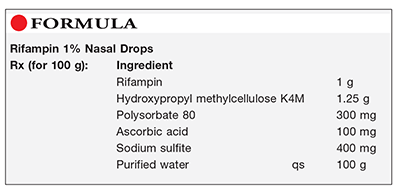US Pharm. 2016;41(7):40-41.

Method of Preparation: Calculate the quantity of each ingredient for the amount to be prepared. Accurately weigh or measure each ingredient. Heat about 90 mL of the purified water to about 70°C and sprinkle on the hydroxypropyl methylcellulose K4M while stirring. After dissolution, cool the mixture to room temperature, add the remaining ingredients, and stir until uniformly dispersed. Add sufficient purified water to final volume and mix well. Package and label.
Use: Rifampin nasal drops are used in the treatment of susceptible infections in the nasal cavity.
Packaging: Package in nasal-drop containers.
Labeling: Keep out of reach of children. Keep refrigerated. Shake gently. Discard after ____ [time period]. For the nose.
Stability: Beyond-use dates of 30 days at room temperature and 76 days at refrigerated temperature have been used.1,2
Quality Control: Quality-control assessment can include weight/volume, pH, specific gravity, active drug assay, color, rheologic properties/pourability, physical observation, and physical stability (discoloration, foreign materials, gas formation, and mold growth).3
Discussion: This formulation is a mucoadhesive formula that will aid in the retention of rifampin in the nasal cavity area after administration.
Rifampin occurs as a nearly odorless, red to reddish-brown, crystalline powder that is slightly soluble in water and ethanol. Its solubility in water is pH-dependent: At pH 2 the solubility is 100 mg/mL, at pH 5.3 it is 4 mg/mL, and at pH 7.5 it drops to 2.8 mg/mL. The aqueous solubility of rifampin may be increased by the addition of ascorbic acid. A 1% aqueous suspension has a pH of 4.5 to 6.5. Rifampin should be protected from exposure to air, moisture, light, and excessive heat. The pH of maximum stability is approximately pH 7; the pH of the above formulation is about 6.5.4
Hypromellose (hydroxypropyl methylcellulose, cellulose, hydroxypropyl methyl ether, Methocel, Pharmacoat) occurs as an odorless and tasteless, white or creamy-white, fibrous or granular powder. It is used as a viscosity-increasing agent and is widely employed in oral and topical formulations. The pH of a 1% aqueous solution is in the range of 5.5 to 8.0. Hypromellose is soluble in cold water, forming a viscous colloidal solution, and it is practically insoluble in alcohol.5
Polysorbate 80 (Tween 80, polyoxyethylene 20 sorbitan monooleate, C64H124O26) has a molecular weight of 1,310. It occurs as a yellow, oily liquid with a characteristic odor and a warm, somewhat bitter taste. Polysorbate 80 has a specific gravity of 1.06 to 1.09 and a hydrophile:lipophile balance value of 15.0.6
Ascorbic acid (l-ascorbic acid, vitamin C, C6H8O6, MW 176.12) occurs as white or slightly yellow crystals or powder. When it is exposed to light, it will gradually darken. Ascorbic acid is reasonably stable in air when dry, but it rapidly oxidizes in solution. Ascorbic acid melts at about 190C; it is freely soluble in water (1:3) and sparingly soluble in alcohol (1:40). It should be stored in airtight, nonmetallic containers and protected from light. A 5% aqueous solution has a pH in the range of 2.1 to 2.6. Ascorbic acid solutions deteriorate rapidly in air.
Sodium sulfite (Na2SO3, MW 126.04) occurs as colorless hygroscopic crystals that are freely soluble in water (1 in 3.2 parts), soluble in glycerin, and slightly soluble in alcohol. It is used as an antioxidant and as an antimicrobial preservative.7
Purified water is water that is obtained by distillation, ion exchange, reverse osmosis, or some other suitable process.8
REFERENCES
1. U.S. Pharmacopeia/National Formulary [current revision]. Rockville, MD: U.S. Pharmacopeial Convention, Inc; June 2016.
2. Rao YM, Devi KM, Ramesha Chary RB. Stability studies of rifampicin mucoadhesive nasal drops. Indian J Pharm Sci. 1999;61:366-370.
3. Allen LV Jr. Standard operating procedure for performing physical quality assessment of oral and topical liquids. IJPC. 1999;3:146-147.
4. Trissel LA. Trissel’s Stability of Compounded Formulations. 5th ed. Washington, DC: American Pharmacists Association; 2012:425-428.
5. Rogers TL. Hypromellose. In: Rowe RC, Sheskey PJ, Cook WG, Fenton ME, eds. Handbook of Pharmaceutical Excipients. 7th ed. London, England: Pharmaceutical Press; 2012:373-376.
6. Zhang D. Polysorbate 80. In: Rowe RC, Sheskey PJ, Quinn ME, eds. Handbook of Pharmaceutical Excipients. 6th ed. London, England: Pharmaceutical Press; 2009:549-553.
7. Sienkiewicz S. Sodium sulfite. In: Rowe RC, Sheskey PJ, Cook WG, Fenton ME, eds. Handbook of Pharmaceutical Excipients. 7th ed. London, England: Pharmaceutical Press; 2012:765-767.
8. Dubash D, Shah U. Water. In: Rowe RC, Sheskey PJ, Cook WG, Quinn ME, eds. Handbook of Pharmaceutical Excipients. 7th ed. London, England: Pharmaceutical Press; 2012:880-884.
To comment on this article, contact rdavidson@uspharmacist.com.





